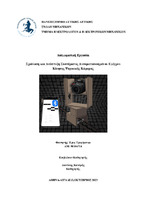| dc.contributor.advisor | Kandris, Dionisis | |
| dc.contributor.author | Τροφίμενκο, Έρικ | |
| dc.date.accessioned | 2023-10-17T12:17:01Z | |
| dc.date.available | 2023-10-17T12:17:01Z | |
| dc.date.issued | 2023-10-11 | |
| dc.identifier.uri | https://polynoe.lib.uniwa.gr/xmlui/handle/11400/5350 | |
| dc.identifier.uri | http://dx.doi.org/10.26265/polynoe-5187 | |
| dc.description.abstract | Αυτή η διπλωματική εργασία εστιάζει στην ανάπτυξη και υλοποίηση μιας λειτουργικής πρωτότυπης συσκευής για τον ασύρματο έλεγχο της κίνησης για ψηφιακές κάμερες, η οποία μπορεί να χρησιμοποιηθεί σε εφαρμογές όπως η βιντεογράφηση – κινηματογράφηση και παρακολούθηση απομακρυσμένων αντικειμένων ή ο έλεγχος συστημάτων ασφαλείας. Ειδικότερα, στο πλαίσιο αυτής της διπλωματικής εργασίας πραγματοποιήθηκε η σχεδίαση και υλοποίηση ενός συστήματος κίνησης μιας ψηφιακής κάμερας, η οποία ελέγχεται ασύρματα από μια συσκευή Android μέσω Bluetooth. Το σύστημα χρησιμοποιεί τρεις βηματικούς κινητήρες Nema 17 και τρεις drivers A4988 για τον έλεγχο της κίνησης της κάμερας όπως την περιστροφή της στον οριζόντιο άξονα (pan), στον κατακόρυφο άξονα (tilt) καθώς και τη μετατόπισή της κατά μήκος μιας ράγας. Ο έλεγχος του συστήματος επιτυγχάνεται μέσω ενός μικροελεγκτή ATmega328. Στη διατριβή αρχικά περιγράφεται η συγκρότηση του υλισμικού και του λογισμικού που απαιτούνται για την υλοποίηση της εφαρμογής, παρέχοντας λεπτομερή ανάλυση των τεχνολογιών που χρησιμοποιήθηκαν και των βημάτων που ακολουθήθηκαν. Στη συνέχεια, αναλύεται η αρχιτεκτονική του συστήματος και η υλοποίηση του σε επίπεδο υλισμικού και λογισμικού. Εξηγείται τη λειτουργία του Bluetooth module και πώς αλληλοεπιδρά με τη συσκευή Android για τον έλεγχο της κίνησης της κάμερας. Επίσης, αναλύεται η λειτουργία του ATmega328 και του κώδικα που χρησιμοποιήθηκε για τον έλεγχο των βηματικών κινητήρων. Τέλος, αναλύονται τα προβλήματα που παρουσιάστηκαν κατά την εκπόνηση του συγκεκριμένου έργου, επεξηγούνται οι διαδικασίες επίλυσής τους, καταγράφονται σχετικές παρατηρήσεις και συμπεράσματα που προέκυψαν και περιγράφονται προτάσεις μελλοντικής εξέλιξης. | el |
| dc.format.extent | 82 | el |
| dc.language.iso | el | el |
| dc.publisher | Πανεπιστήμιο Δυτικής Αττικής | el |
| dc.rights | Αναφορά Δημιουργού - Μη Εμπορική Χρήση - Παρόμοια Διανομή 4.0 Διεθνές | * |
| dc.rights | Attribution-NonCommercial-NoDerivatives 4.0 Διεθνές | * |
| dc.rights.uri | http://creativecommons.org/licenses/by-nc-nd/4.0/ | * |
| dc.subject | Ολισθητήρας κάμερας | el |
| dc.subject | Κινηματογράφηση | el |
| dc.subject | Βιντεογράφηση | el |
| dc.subject | Κίνηση κάμερας | el |
| dc.subject | Έλεγχος κάμερας | el |
| dc.subject | Αυτοματισμός | el |
| dc.subject | Βηματικοί κινητήρες | el |
| dc.subject | Παντοκατευθυντική κάμερα | el |
| dc.subject | Bluetooth | el |
| dc.subject | ATmega328p | el |
| dc.subject | Android | el |
| dc.subject | Ψηφιακή κάμερα | el |
| dc.subject | Arduino Nano | el |
| dc.title | Σχεδίαση και ανάπτυξη συστήματος αυτοματοποιημένου ελέγχου κίνησης ψηφιακής κάμερας | el |
| dc.title.alternative | Design and development of an automated camera slider system | el |
| dc.type | Διπλωματική εργασία | el |
| dc.contributor.committee | Alexandridis, Alex | |
| dc.contributor.committee | Zois, Elias | |
| dc.contributor.faculty | Σχολή Μηχανικών | el |
| dc.contributor.department | Τμήμα Ηλεκτρολόγων και Ηλεκτρονικών Μηχανικών | el |
| dc.description.abstracttranslated | This thesis focuses on the development and implementation of a functional prototype device for wireless motion control for digital cameras, which can be used in applications such as remote object videography and monitoring or security system control. In particular, in the context of this diploma thesis, the design and implementation of a motion system for a digital camera, which is wirelessly controlled by an Android device via Bluetooth, is carried out. The system uses three Nema 17 stepper motors and three A4988 drivers to control the movement of the camera such as its rotation on the horizontal axis (pan), on the vertical axis (tilt) as well as its displacement along a rail. Control of the system is achieved through an ATmega328 microcontroller. In the document of this thesis at first the construction of the hardware and software required for the implementation of the application is described, providing a detailed analysis of the technologies used and the steps followed. Then, the system architecture and its implementation at the hardware and software level are analyzed. The function of the Bluetooth module and how it interacts with the Android device to control the camera movement is explained. Also, the operation of the ATmega328 and the code used to control the stepper motors is described. Finally, the problems presented during the development of the specific project are analyzed, the procedures for solving them are explained, relevant observations made and conclusions drawn are recorded, and proposals for future
development are described. | el |


